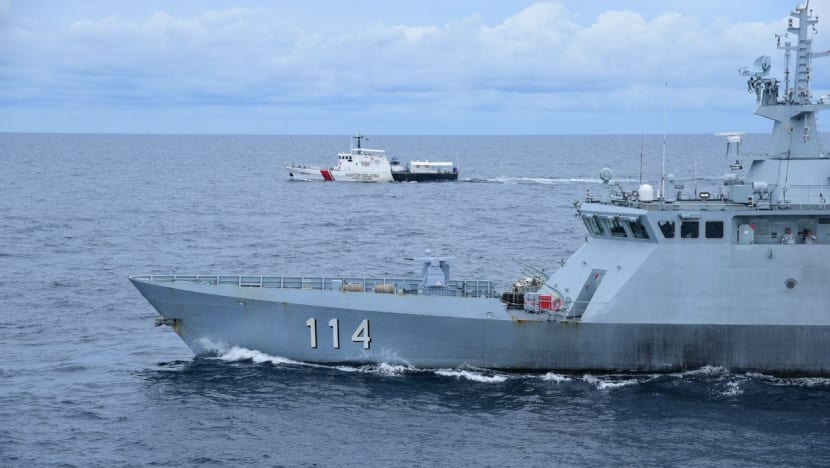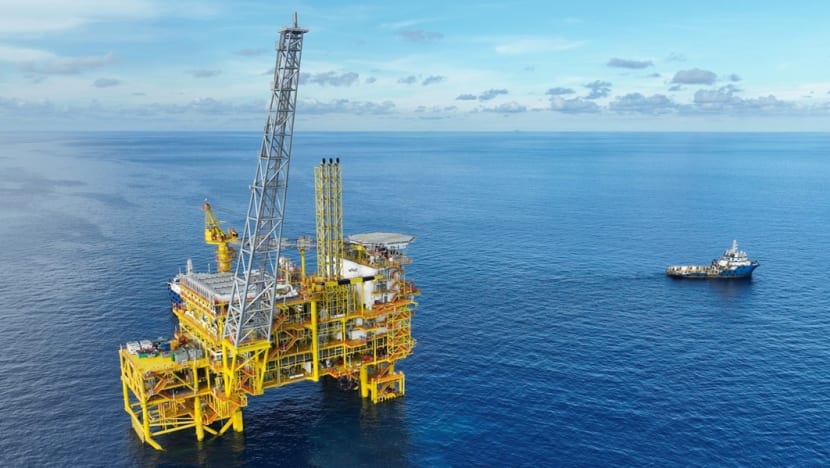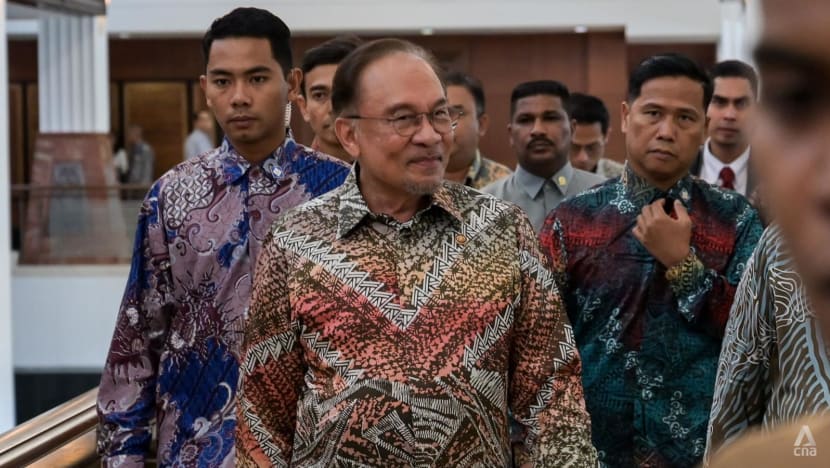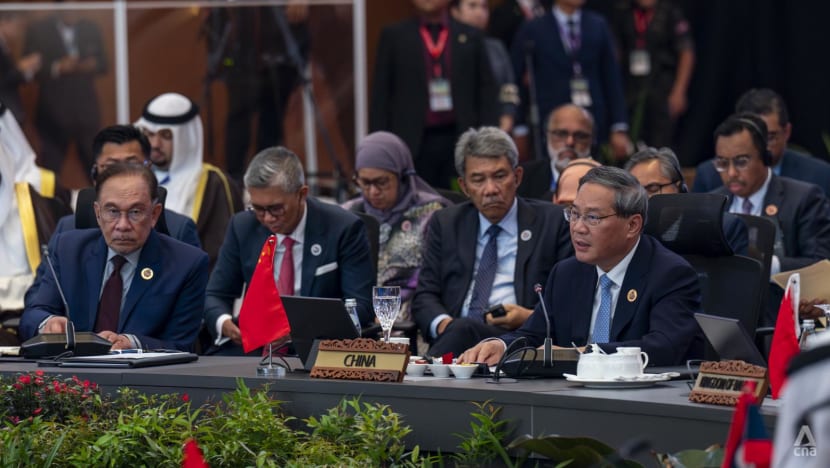analysis Asia
Malaysia steps up ways to 'confront threats' in South China Sea, but will this rock the boat?
Malaysia is making maritime security a key national development pillar after sustained Chinese pressure and illegal fishing by Vietnamese vessels in its exclusive economic zones, analysts say.

Royal Malaysian Navy littoral mission ship KD Rencong, from the HQ Eastern Fleet at Teluk Sepanggar naval base that oversees the waters off Sabah and Sarawak, taking part in a maritime exercise on security in the South China Sea in September 2024. (Photo: Facebook/Markas Pemerintahan Armada Timur)

This audio is generated by an AI tool.
KUALA LUMPUR: The 13th Malaysia Plan outlining the country’s latest five-year development includes the usual goals of economic growth, among others, but it is what Prime Minister Anwar Ibrahim said about defence and security that has caught observers by surprise.
Particularly striking was how he singled out where the focus of military deterrence efforts would be.
"Readiness to confront sovereignty and security threats in the South China Sea will be intensified more comprehensively," he said when tabling the development roadmap in parliament on Jul 31.
While the 12th Malaysia Plan - tabled by then-Prime Minister Ismail Sabri Yaakob in 2021 - spoke about improving defence capabilities in general terms, the mention of the disputed and resource-rich waterway in the newest edition of the roadmap could bring deeper meaning, analysts told CNA.
The Malaysian government could allocate specific budgets for more effective monitoring of its offshore resource areas, while the military aims to do more with less to counter threats in the strategic sea, possibly by buying more unmanned aerial vehicles (UAV), the experts added.
“The 13th Malaysia Plan is basically a strategic economic plan, but I was surprised the issue of sovereignty was included,” said Abdul Rahman Yaacob, a research fellow in the Southeast Asia programme at the Lowy Institute think tank in Australia.
“But Malaysian concerns over the South China Sea are not surprising. It has been building up its military capabilities in East Malaysia.”
Putrajaya is in the midst of adding long-range radars, long-endurance drones and a new naval base in Sarawak expected to be capable of launching submarines to boost its security posture in the South China Sea.
The unusual reference to the sea in such a significant national document could have come in the face of sustained pressure by China's naval forces and illegal fishing by Vietnamese vessels in Malaysia’s Exclusive Economic Zones (EEZ) off its Borneo states and peninsular east coast, the observers said.
But even with this new focus, the experts do not expect a change in Malaysia's long-adopted non-confrontational stance on South China Sea disputes, saying that Putrajaya will continue to prioritise strong bilateral ties with claimant states for mutual economic benefit.
While China claims much of the South China Sea, other Association of Southeast Asian Nations (ASEAN) states that have laid a claim to the important waterway include Brunei, the Philippines and Vietnam.
Thomas Daniel, director of foreign policy and security studies programme at Malaysia’s Institute of Strategic & International Studies (ISIS) think tank, told CNA that while China is a “big factor” behind Malaysia’s move to include the South China Sea as part of its five-year development roadmap, it is not the only reason for it.
"China is the one player in the South China Sea with the ability to change the status quo. And Malaysia, over the years, has been facing very steady pressure from the PRC," he told CNA, referring to the People's Republic of China.
“Another major challenge for Malaysia is actually illegal, unreported and unregulated fishing by Vietnamese fishing fleets. If you speak to Malaysian officials, this probably grates them more than the PRC.”
Jamil Ghani, a doctoral candidate at Singapore’s S Rajaratnam School of International Studies (RSIS), cited how such commercial fishing vessels have acted as means of human and wildlife trafficking between Malaysia and Vietnam.
These factors, alongside China’s grey-zone presence, overlapping claims, and pressure from Sabah and Sarawak leaders in Borneo, have "coalesced" to make maritime security a central pillar of Malaysia’s national development strategy, he said.
"It marks a shift from vague defence rhetoric to actionable policy.”
SOUTH CHINA SEA THREATS
Public tracking data from the Washington-based Asia Maritime Transparency Initiative showed that in 2024, the China Coast Guard patrolled the Luconia Shoals for 359 ship days, meaning a coast guard vessel was on station nearly every day, Jamil noted.
Ship days refers to the number of days a specific ship or a group of ships is present in a particular area, used to track the intensity and duration of maritime patrols.
Malaysia’s EEZ comprises areas abundant in oil and gas that it says contribute almost 25 per cent to its gross domestic product (GDP). These include the Luconia Shoals, a group of mostly submerged reefs that lie between various Malaysian oil and gas sites 155km off the coast of Sarawak.
China, which claims most of the South China Sea within its so-called nine-dash line, has regularly protested Malaysia’s activities in the Luconia Shoals. Malaysia has said it will continue exploratory activities in its sovereign waters.
China Coast Guard vessels at Luconia also made frequent visits to Malaysia’s new exploratory wells drilled off Sarawak, approaching within 1km of several oil and gas platforms, Jamil said.
This represented China’s “sustained grey‑zone pressure over both sovereignty and energy infrastructure”, he said, using a term that describes coercive actions which fall below the threshold of conventional warfare.

On fishing encroachments, ISIS’ Daniel said Vietnamese boats were fishing illegally in Malaysian waters because fish stocks closer to home have dwindled due to pressure from Vietnam’s large-scale fishing industry.
“Our fishing is minuscule compared to them, and our waters are not patrolled because there are no assets; there's no maritime domain awareness,” Daniel said.
“And when Malaysian coast guard vessels move to interdict, there are problems sometimes. Vietnamese fishermen have been known to be very aggressive. Some of them are armed. There have been shots fired.”
Between mid-2019 and September 2024, the Malaysian Maritime Enforcement Agency (MMEA) detained 598 fishing vessels, three-quarters of which were Vietnamese, Jamil said.
“Adding a more insidious security dimension, a January 2025 study … revealed that commercial fishing vessels have become conduits for smuggling endangered animal parts and human trafficking between Malaysia and Vietnam,” he said.
The study - conducted by wild cat conservation organisation Panthera, Sunway University’s Jeffrey Sachs Center, and the Zoological Society of London - found that deepening economic vulnerabilities in the fisheries sector were fuelling convergence between illegal, unreported and unregulated fishing, wildlife crime and forced labour networks.
Moving forward, it would make sense for Malaysia to buy assets that could detect and share information about incursions with other ground, air and naval units, Daniel said.
“What does it mean? Hopefully acquiring more naval and air assets, manned and unmanned, that are able to talk to each other and increase our awareness and our capacity to respond,” he said.
Collin Koh, a senior fellow at RSIS’ Institute of Defence and Strategic Studies, acknowledged that Malaysia faces a range of security challenges across its vast maritime zone.
But he believes Chinese pressure in the disputed waterway off Borneo “is by far the most intractable by comparison”.
Ramping up Malaysia's security posture in the South China Sea would symbolise the Anwar administration’s fulfilment of its obligations towards the two Borneo states, amid their push for greater autonomy including in energy revenue, Koh said.
“There’s certainly the inescapable geo-economic dimension to it, and that has a lot to do with Malaysia’s offshore energy interests in its Borneo EEZs,” he added.
DRONES, RADARS AND JETS
A stronger commitment to protect these interests means the Malaysian government could try to do more with less in terms of military assets, Daniel said.
Malaysia’s military has faced well-documented procurement, maintenance and obsolescence issues, even as Putrajaya aims to raise defence spending from the current 1.1 per cent to 1.5 per cent of its GDP by 2030.
In 2024, the defence budgets of Southeast Asian countries ranged between 0.78 per cent (Indonesia) and 4.09 per cent (Myanmar) of their respective GDP.
Koh noted that in 2021, Malaysia could scramble only its old Hawk fighter jets to intercept Chinese combat aircraft flying towards Malaysian airspace off Sabah.
“Overall, the strategic orientation of the Malaysian Armed Forces (MAF) build-up appears to be in no small part geared towards the South China Sea, besides the pragmatic consideration about growing obsolescence across the armed forces’ array of equipment,” he said.
Malaysia has agreed to buy an additional two long-range radars from France to deploy both on the peninsula and in East Malaysia, and is set to receive three Turkish-made long-endurance drones by March 2026.
The drones will be based at Labuan Air Base in Borneo and provide sustained intelligence, surveillance and reconnaissance over Malaysia’s EEZ, Jamil said. In May, Defence Minister Khaled Nordin pledged more investments in UAV technology.
Malaysia is also finalising the purchase of up to 33 used F/A-18C/D Hornet fighter jets from Kuwait, although Daniel noted they would need to be upgraded to be on par with the Royal Malaysian Air Force’s fleet of eight F/A-18D Hornets.
“The choice of second-hand Hornets from Kuwait isn’t just to do with stock availability and operational familiarity, but also the fact that the jet is designed and optimised for overwater operations,” Koh said.
It is not yet clear where the used Hornets - slated for delivery between late 2025 and 2026 - will be based.
“If deployed to East Malaysia, the Hornets would complement the new naval infrastructure in Sarawak and enable more persistent air coverage over offshore resource zones,” Jamil said.
BEYOND HARDWARE
Still, Malaysia will look “beyond just hardware and software capability buildup”, Koh said, pointing to its plan to build a new naval base in Muara Tebas, near the Sarawak capital of Kuching.
The site offers “rapid access to the open sea” and its suitably deep waters mean it could serve as a forward transit point for Malaysia’s Scorpene-class submarines, improving maritime domain awareness in the South China Sea, Jamil said.
The Sarawak Economic Development Corporation is conducting a feasibility study that is expected to conclude by the first quarter of 2026, with construction potentially starting soon after.
The base, listed as a priority project under the 13th Malaysia Plan, was initially planned for construction further east in Bintulu closer to the EEZ, but was relocated over 500km away to Muara Tebas due to “various factors”, local media reported.

It is not just about the navy. In his 13th Malaysia Plan speech, Anwar vowed to build an "integrated, agile and focused future force" to ensure the country’s stability and prosperity.
“There’s also in recent years growing inter-agency cooperation between MAF, especially the Royal Malaysian Navy, and MMEA to enhance joint response to maritime contingency,” Koh said, drawing comparisons to how China uses both its navy and coast guard to “assert physical dominance” in the South China Sea.
Anwar’s statement reflects a thinking among Malaysian defence planners that the MAF, given its limited size and budget, needs to spend “wisely”, Daniel said.
“I think what you will see is, in long-term development plans especially on defence, more specific allocations for increasing capabilities that would allow Malaysia to sustain a presence for a longer period of time in disputed areas,” he said.
“It takes not just focused planning from defence planners, but also the political buy-in and the buy-in of the people who hold the purse strings - the Ministry of Finance. They need to ensure that this plan is not deviated by other national interests.”
HEDGING HERE TO STAY
Analysts, however, agree it is firmly in Malaysia’s national interests to maintain its current diplomatic approach to South China Sea disputes.
“Malaysia has always had a very consistent approach to the South China Sea - segmentise this dispute and not allow it to interfere with other other aspects of its bilateral relations,” said ISIS’ Daniel.
“Whether it's (due to) China or not, it is generally a good idea for the government to seriously devote some thinking and resources into long-term developments of the navy and air force.”

Jamil from RSIS believes Malaysia is likely to maintain its China-friendly, non-confrontational diplomatic stance even as it strengthens its defence posture in the South China Sea.
“Rather than adopting overt assertiveness, Malaysia is pursuing a quiet deterrence-by-denial strategy, allowing it to raise the operational costs of incursions without escalating tensions,” he said.
“At the bilateral level, it will continue framing China as a strategic partner, opting for protest notes and legal reaffirmations over public confrontations.”
Meanwhile, Malaysia is expected to become more active multilaterally, using ASEAN platforms to push for an enforceable code of conduct for the South China Sea, Jamil said.
“In essence, Malaysia is hedging: Reinforcing sovereignty on the ground while preserving diplomatic space for cooperation with Beijing,” he added.






















